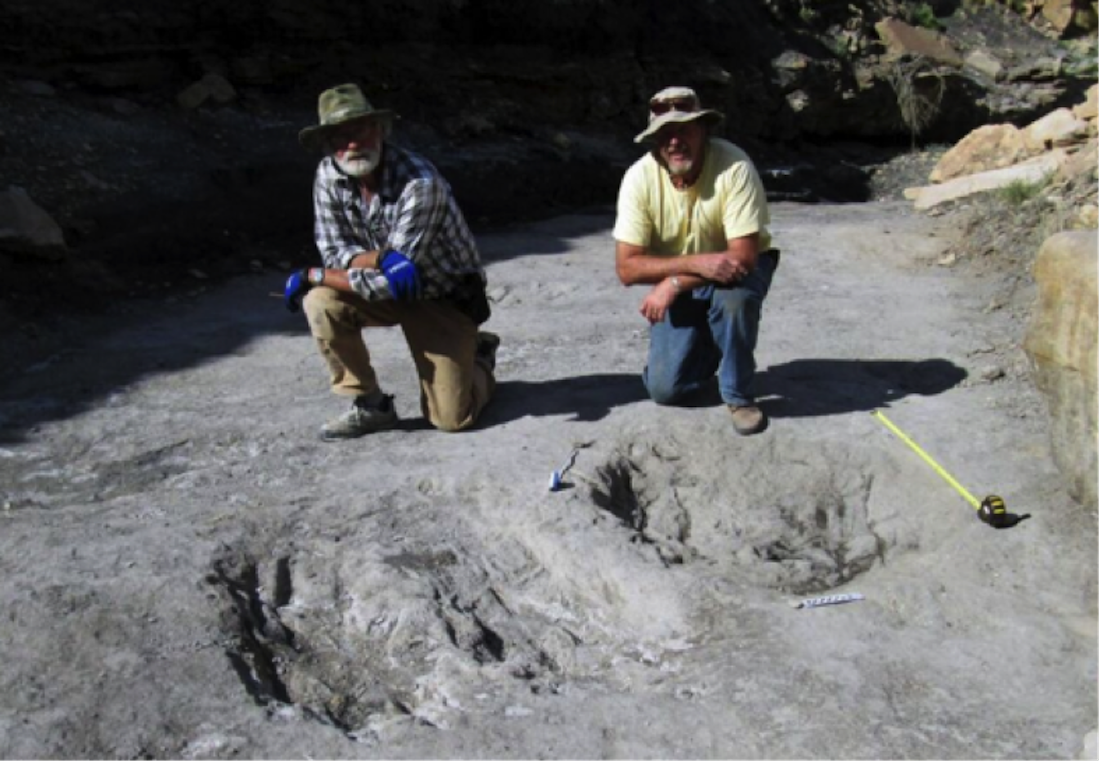By Kathleen Ferraro
The first physical evidence of dinosaur lovefests–long grooves likely created by amorous dinosaurs in the throes of a courtship ritual–has been discovered in Western Colorado, researchers are reporting.
Paleontologist Martin Lockley, of the University of Colorado at Denver, along with an international research team, discovered scrapes likely made by two-legged, meat-eating theropod dinosaurs about 100 million years ago. The scrapes, evidencing an ardent pawing of the sandstone, parallel modern birds’ breeding behaviors, the researchers said.
They reported their results in the current edition of the journal Scientific Reports.
“We’ve found several large areas where tracks of carnivorous dinosaurs … with dozens of large scrapes, some the size of bath tubs,” Lockley said. “These are also the first sites with evidence of dinosaur display rituals ever discovered, and the first physical evidence of courtship behavior.”

Lockley and his team found more than 50 dinosaur scrape display areas, known as leks, in Western Colorado.The scrapes are the remnants of “scrape ceremonies,” the researchers said. During the ceremonies, male dinosaurs would likely have shown off to females by pawing “pseudo nests” out of the sandstone, according to the research team.

“They were probably not only excited but impressively vocal,” Lockley said of the foreplay. “It was perhaps like spring break in the Cretaceous [the geologic period from 145 ± 4 to 66 million years ago]: courtship has a very long history.”
Some modern bird species partake in similar “nest scrape displays,” carving pseudo nests to attract mates. Birds’ scrape ceremonies often occur near their final nesting sites. Given this proximity, finding the right type of dinosaur scrapes could indicate a nearby dinosaur nesting site, according to the research team.
Though the scrapes resemble the courtship markings from contemporary birds, paleontologists not involved in the research suggested possible alternative explanations for the grooves.
Some critics contend that the area might be a nest site, though the lack of eggshells or hatchlings’ bones is evidence to the contrary. Another explanation is that dinosaurs digging for food or water created the scrapes, though the abundance of water in the area suggests such measures would not have been necessary.
The scrapes may also be territorial markings, similar to a cat marking its territory with urine. However, scent marking is a mammalian behavior and likely not characteristic of dinosaurs.

University of Michigan paleontologist Jeff Wilson, who was not involved in the research, found the sandstone grooves noteworthy.
“What struck me was that those traces are wild looking. I have never seen a trace like that before, and I think they’re pretty interesting for that reason,” Wilson said. “With these traces, you have direct evidence of what [dinosaurs] did in life, which is super powerful.”
Nonetheless, he expressed skepticism, citing a lack of nesting evidence and a need for more parallels between avian marks and the scrapes.
“I’m not strongly convinced that these are what they say they are because these are such a specific thing,” said Wilson. “They’re drawing a very specific inference from these tracks.”
Still, Lockley and his team stacked up their evidence against other theories and found it to be the most plausible.
“Were dinosaurs the first lovebirds, and did the first dinosaur romances take place on ancient beaches that are today preserved as sandstones at Dinosaur Ridge and Colorado’s western slope?” Lockley and colleagues wrote. “The scientific evidence points strongly in this direction.”

